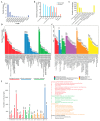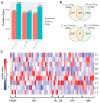De Novo Transcriptome Identifies Olfactory Genes in Diachasmimorpha longicaudata (Ashmead)
- PMID: 32013248
- PMCID: PMC7074194
- DOI: 10.3390/genes11020144
De Novo Transcriptome Identifies Olfactory Genes in Diachasmimorpha longicaudata (Ashmead)
Abstract
Diachasmimoorpha longicaudata (Ashmead, D. longicaudata) (Hymenoptera: Braconidae) is a solitary species of parasitoid wasp and widely used in integrated pest management (IPM) programs as a biological control agent in order to suppress tephritid fruit flies of economic importance. Although many studies have investigated the behaviors in the detection of their hosts, little is known of the molecular information of their chemosensory system. We assembled the first transcriptome of D. longgicaudata using transcriptome sequencing and identified 162,621 unigenes for the Ashmead insects in response to fruit flies fed with different fruits (guava, mango, and carambola). We annotated these transcripts on both the gene and protein levels by aligning them to databases (e.g., NR, NT, KEGG, GO, PFAM, UniProt/SwissProt) and prediction software (e.g., SignalP, RNAMMER, TMHMM Sever). CPC2 and MIREAP were used to predict the potential noncoding RNAs and microRNAs, respectively. Based on these annotations, we found 43, 69, 60, 689, 26 and 14 transcripts encoding odorant-binding protein (OBP), chemosensory proteins (CSPs), gustatory receptor (GR), odorant receptor (OR), odorant ionotropic receptor (IR), and sensory neuron membrane protein (SNMP), respectively. Sequence analysis identified the conserved six Cys in OBP sequences and phylogenetic analysis further supported the identification of OBPs and CSPs. Furthermore, 9 OBPs, 13 CSPs, 3 GRs, 4IRs, 25 ORs, and 4 SNMPs were differentially expressed in the insects in response to fruit flies with different scents. These results support that the olfactory genes of the parasitoid wasps were specifically expressed in response to their hosts with different scents. Our findings improve our understanding of the behaviors of insects in the detection of their hosts on the molecular level. More importantly, it provides a valuable resource for D. longicaudata research and will benefit the IPM programs and other researchers in this filed.
Keywords: Ashmead; Diachasmimorpha longicaudata; chemosensory protein; odorant-binding protein; olfactory protein; parasitoid wasps; transcriptome.
Conflict of interest statement
The authors declare no conflict of interest.
Figures




Similar articles
-
Identification of candidate genes associated with host-seeking behavior in the parasitoid wasp Diachasmimorpha longicaudata.BMC Genomics. 2024 Feb 6;25(1):147. doi: 10.1186/s12864-024-10034-6. BMC Genomics. 2024. PMID: 38321385 Free PMC article.
-
Antennal transcriptome analysis and comparison of olfactory genes in two sympatric defoliators, Dendrolimus houi and Dendrolimus kikuchii (Lepidoptera: Lasiocampidae).Insect Biochem Mol Biol. 2014 Sep;52:69-81. doi: 10.1016/j.ibmb.2014.06.006. Epub 2014 Jul 3. Insect Biochem Mol Biol. 2014. PMID: 24998398
-
Identification of the genes involved in odorant reception and detection in the palm weevil Rhynchophorus ferrugineus, an important quarantine pest, by antennal transcriptome analysis.BMC Genomics. 2016 Jan 22;17:69. doi: 10.1186/s12864-016-2362-6. BMC Genomics. 2016. PMID: 26800671 Free PMC article.
-
The role of SNMPs in insect olfaction.Cell Tissue Res. 2021 Jan;383(1):21-33. doi: 10.1007/s00441-020-03336-0. Epub 2020 Nov 27. Cell Tissue Res. 2021. PMID: 33245414 Free PMC article. Review.
-
Comprehensive History of CSP Genes: Evolution, Phylogenetic Distribution and Functions.Genes (Basel). 2020 Apr 10;11(4):413. doi: 10.3390/genes11040413. Genes (Basel). 2020. PMID: 32290210 Free PMC article. Review.
Cited by
-
Identification and characterization of soluble binding proteins associated with host foraging in the parasitoid wasp Diachasmimorpha longicaudata.PLoS One. 2021 Jun 17;16(6):e0252765. doi: 10.1371/journal.pone.0252765. eCollection 2021. PLoS One. 2021. PMID: 34138896 Free PMC article.
-
Identification of candidate genes associated with host-seeking behavior in the parasitoid wasp Diachasmimorpha longicaudata.BMC Genomics. 2024 Feb 6;25(1):147. doi: 10.1186/s12864-024-10034-6. BMC Genomics. 2024. PMID: 38321385 Free PMC article.
-
Molecular Characterization and Functional Analysis of Odorant-Binding Proteins in Ectropis grisescens.Int J Mol Sci. 2025 May 10;26(10):4568. doi: 10.3390/ijms26104568. Int J Mol Sci. 2025. PMID: 40429713 Free PMC article.
-
Special Issue "Olfaction: From Genes to Behavior".Genes (Basel). 2020 Jun 15;11(6):654. doi: 10.3390/genes11060654. Genes (Basel). 2020. PMID: 32549403 Free PMC article.
-
Genetic mechanisms modulating behaviour through plastic chemosensory responses in insects.Mol Ecol. 2023 Jan;32(1):45-60. doi: 10.1111/mec.16739. Epub 2022 Nov 2. Mol Ecol. 2023. PMID: 36239485 Free PMC article. Review.
References
-
- White I.M., Elson-Harris M.M. Fruit Flies of Economic Significance: Their Identification and Bionomics. CAB International; Wallingford, UK: 1992.
-
- Greany P.D., Tumlinson J.H., Chambers D.L., Boush G.M. Chemically mediated host finding byBiosteres (Opius) longicaudatus, a parasitoid of tephritid fruit fly larvae. J. Chem. Ecol. 1977;3:189–195. doi: 10.1007/BF00994145. - DOI
-
- Carrasco M., Montoya P., Cruz-lopez L., Rojas J.C. Response of the Fruit Fly Parasitoid Diachasmimorpha longicaudata (Hymenoptera: Braconidae) to Mango Fruit Volatiles. Environ. Entomol. 2005;34:576–583. doi: 10.1603/0046-225X-34.3.576. - DOI
-
- Silva J.W.P., Bento J.M.S., Zucchi R.A. Olfactory response of three parasitoid species (Hymenoptera: Braconidae) to volatiles of guavas infested or not with fruit fly larvae (Diptera: Tephritidae) Biol. Control. 2007;41:304–311. doi: 10.1016/j.biocontrol.2007.03.005. - DOI
Publication types
MeSH terms
Substances
LinkOut - more resources
Full Text Sources
Research Materials

